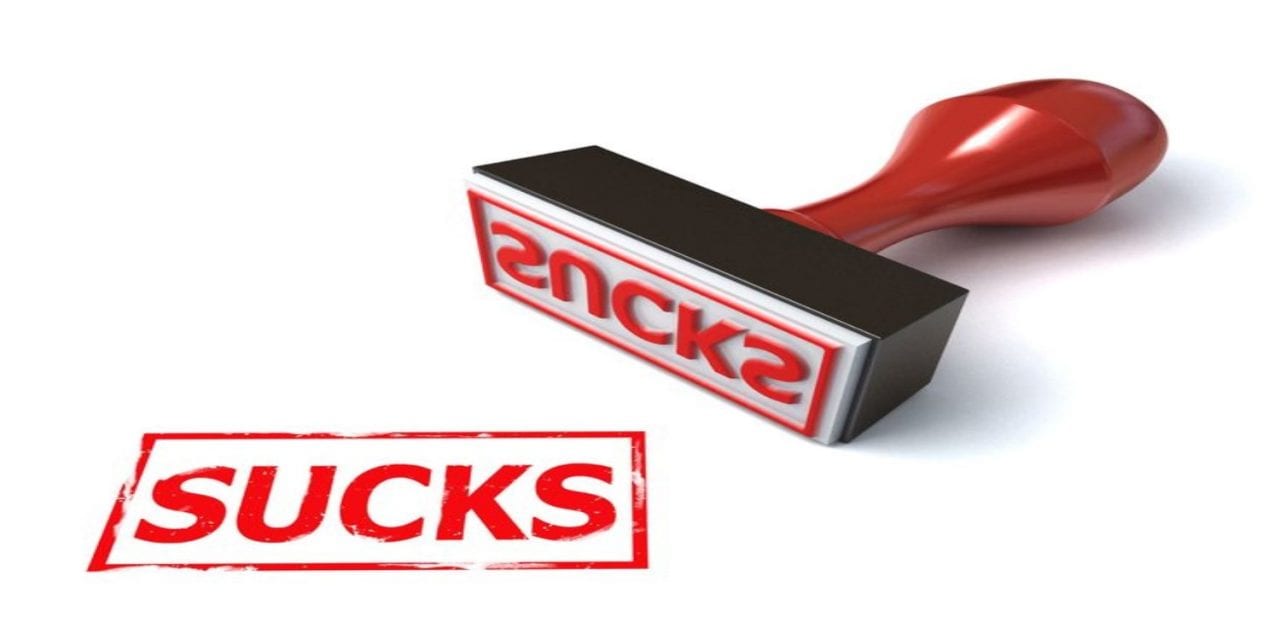Seriously… you really do suck at marketing. But you don’t have to stay that way.
By Dan Hutson
I had the opportunity to attend Content Marketing World last week. This is the largest gathering of content marketing professionals in the world, and once again—this is my third year—I found senior living industry marketing pros entirely absent. OK, maybe that isn’t fair. One year I did meet two other senior living marketers … from the same place. So, two organizations were represented. Yay.
My first thought for this post was to write about my key takeaways from this year’s conference, but then I had an insight—why bother? What’s the value of key takeaways when there’s no one around to use them? The number of people in our industry who are taking content marketing seriously can be counted on one hand of the NFL player who never learned the rules of fireworks safety.
(Quick digression: Don’t hold onto fireworks while they’re going off. Or set them off on your chest. Or on top of your head. OK, back to content marketing.)
It continues to confound me why more senior living marketers aren’t making a serious commitment to content marketing. Is it fear of the unknown? Inertia? Is traditional outbound marketing working so well for them that they don’t see the need to change? Yes, yes and maybe—but I doubt it.
To its credit, LeadingAge rolled out a “content marketing with training wheels” approach last October when it joined forces with Next Avenue, the PBS website for people 50+, to provide its members with “exclusive, ready-to-use content” on a subscription basis. Boilerplate content is no substitute for developing a content marketing strategy and then building highly individualized branded content to meet your prospects’ specific informational needs, but it’s better than nothing.
I think it’s fair to say that senior living hasn’t always adapted well to technological change (maybe that should be “has never”). But being willfully ignorant of the changes technology is driving in the marketing arena is a sure path to obsolescence and unemployment.
A few thoughts in no particular order for your consideration:
Mass Marketing Stinks For Senior Living
It’s past time to acknowledge that traditional outbound marketing is not an effective approach for our business. Putting a message in front of as many people as possible in the hope of finding a few qualified buyers has never been a good strategy for a niche product like senior living.
It’s one-way communication that doesn’t allow for dialogue. It’s expensive and wasteful—you inevitably hit many people who will never be your customer. Mass marketing by definition isn’t personalized, so you’re pushing one message at a time even when individuals have different needs and desires. And it’s highly perishable. Good luck showing up in front of that qualified prospect at the exact moment they’re receptive to what you’re selling.
The Consumer Is In The Catbird Seat
You may have heard the phrase “content is king.” It isn’t—the consumer is king, queen and all the other face cards in the deck. Our job is to provide solutions to consumer problems and support to help them do what they need/want to do. It’s literally that simple.
Technology and changing consumer behaviors have altered our marketing landscape forever. Today’s consumer decides when to evaluate, where to turn for answers and who should be on the short list for consideration. The same technology that enables us to cost-effectively reach more people has made it infinitely easier for them to screen us out. A few fun facts:
- 220 million Americans have registered their phone numbers with the Federal Trade Commission’s National Do Not Call Registry.
- 86 percent of TV viewers use tech to skip advertising.
- Newspaper paid circulation has been on a steady downward decline for the past 20 years.
- Nearly half of all direct mail is never opened.
- 91 percent of email users who previously opted into receiving communication have subsequently unsubscribed.
Still think sticking ads in front of eyeballs, dropping mail in every mailbox, interrupting people’s dinners with phone calls and generally making a nuisance of yourself is the way to go?
It’s About Them, Not You
And yet we still see websites that focus on our wonderful amenities, great location, superior quality, blah blah blah. When everyone is talking about how great their community is, how are you truly differentiating yourself from the competition?
What if instead you provided content that answered the questions highest on prospects’ minds — what does it cost, how will I pay for it, what’s life like in a community, how will you help me accomplish what I want to accomplish, and so on?
No one cares about how awesome your organization is. They care about themselves. They care about their families. And they care about how your community is going to help them meet their needs.
In an age of media saturation, people know when they’re being marketed to. You can either do it in a way that puts your goals first, or you can help consumers make smarter decisions for themselves. Helpful content puts the customer first, opens doors and establishes trust. It gains you permission to dig deeper and eventually ask for the sale. It also differentiates you from the competition because, sadly, not a lot of us in this industry are taking this approach.
Answer The Right Question
OK, I’ll share one takeaway from CMW. This comes from John Jantsch, the author of Duct Tape Marketing and other smart books on sales and marketing. He says you’ve got to answer the right question in consumers’ minds: why buy anything, not why buy from us. I think this is particularly true for our industry, where we know our biggest competitor is the home in which our prospects currently reside. Selling the idea of community living has to come before selling your community.
As A Marketer, You Have Three Jobs
Educate the consumer. Demystify the senior living experience through storytelling. Provide tools that help people act on what they’ve learned. If you do a good job at these three things, I guarantee you will have done more to move a prospect toward a purchase decision than any newspaper ad, marketing brochure, community tour or “dine and discover” event.
No One Has All The Answers
Remember a few years ago when every agency pitching you their services was a social media guru? Now they’re all content marketing masters. The thing to remember is that we’re at a very early stage in the development of content marketing. No one’s “mastered” anything. We’re all figuring it out as we go along. Sometimes it’s on the basis of good, actionable data. Sometimes not. Keep this in mind as you listen to all the newly-minted “experts” out there.
One Last Thing …
Phillip Kotler, a professor at Northwestern’s Kellogg School of Management and one of the world’s foremost authorities on marketing, had this to say about this business we’re in (marketing, not senior living): “Marketing is not the art of finding clever ways to dispose of what you make. It is the art of creating genuine customer value.”
We’re well past the point of moving beyond clever ways to sell our wares to creating real value for those we serve. Let’s start acting like it.








